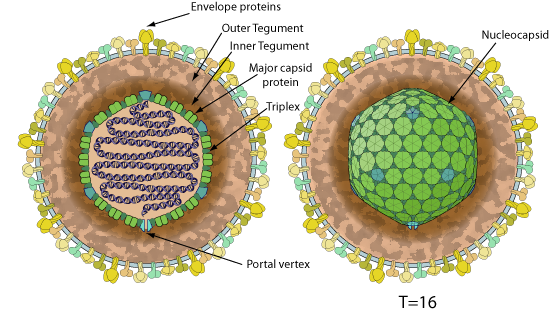Lymphocryptovirus (taxid:10375)
VIRION

Enveloped, spherical to pleomorphic, 150-200 nm in diameter, T=16 icosahedral symmetry. Capsid consists of 162 capsomers and is surrounded by an amorphous tegument. Glycoproteins complexes are embedded in the lipid envelope.
GENOME
Monopartite, linear, dsDNA genome of about 180 kb. The genome contains terminal and internal reiterated sequences.
GENE EXPRESSION
Each viral transcript usually encodes a single protein and has a promoter/regulatory sequence, a TATA box, a transcription initiation site, a 5' leader sequence of 30-300 bp (not translated), a 3' untranslated sequence of 10-30 bp, and a poly A signal. There are many gene overlaps. There are only few spliced genes. Some of the expressed ORFs are antisense to each other. Some ORFs can be accessed from more than one promoter. There are some non-coding genes.
ENZYMES
- DNA-dependent DNA polymerase
- DNA primase
- Tegument deneddylase (Peptidase C76)
- Assemblin (Peptidase S21)
- Kinase
- Helicase
- Ribonucleoside-diphosphate reductase
- Thymidine kinase
- Uracil-DNA glycosylase
REPLICATION
NUCLEAR
Lytic replication:
- Attachment of the viral glycoproteins to host receptors mediates endocytosis of the virus into the host cell.
- Fusion with the plasma membrane to release the core and the tegument proteins into the host cytoplasm.
- The capsid is transported to the nuclear pore where the viral DNA is released into the nucleus.
- Transcription of immediate early genes which promote transcription of early genes and protect the virus against innate host immunity.
- Transcription of early viral mRNA by host polymerase II, encoding proteins involved in replication of the viral DNA.
- A first round of circular genome amplification occurs by bidirectional replication
- Synthesis of linear concatemer copies of viral DNA by rolling circle.
- Transcription of late mRNAs by host polymerase II, encoding structural proteins.
- Assembly of the virus in nuclear viral factories and budding through the inner lamella of the nuclear membrane which has been modified by the insertion of herpes glycoproteins, throughout the Golgi and final release at the plasma membrane.
Latent replication : replication of circular viral episome in tandem with the host cell DNA using the host cell replication machinery.
Host-virus interaction
Adaptive immune response inhibition
Epstein-Barr virus protein BNLF2a inhibits host adaptive immune response by interacting with TAP1 and TAP2 and thus preventing TAP-mediated peptide transport and subsequent loading. The glycine-alanine repeat domain (GAr) of Epstein-Barr virus-encoded nuclear antigen 1 (EBNA1) prevents major histocompatibility complex (MHC) class I-restricted presentation of EBNA1 epitopes to cytotoxic T cells.
Apoptosis modulation
Epstein-Barr viral protein BHRF1 is a viral homologue of the Bcl-2 oncogene that is able to protect cells from induced apoptosis. EBNA3C directly interacts with host Gemin3 and thereby blocks p53-mediated apoptosis  .
.
Autophagy modulation
The viral Bcl-2 homolog BHRF1 in addition to prevent host cel death, may also control host autophagy  .
.
Cell-cycle modulation
EBNA3C forms a complex with Cyclin D1 thereby facilitating the G1-S phase transition  . Additionally, EBNA2 can affect activities of cell cycle regulators and retards cell cycle progression at G2/M phase.
The conserved UL24 family of human alpha, beta and gamma herpesviruses induces a cell cycle arrest at G2/M transition through inactivation of the host cyclinB/cdc2 complex. EBV encodes an UL24 homolog termed BXRF1 that should perform this role
. Additionally, EBNA2 can affect activities of cell cycle regulators and retards cell cycle progression at G2/M phase.
The conserved UL24 family of human alpha, beta and gamma herpesviruses induces a cell cycle arrest at G2/M transition through inactivation of the host cyclinB/cdc2 complex. EBV encodes an UL24 homolog termed BXRF1 that should perform this role  .
.
Innate immune response inhibition
EBV inhibits the cascade leading to production of interferon-beta by targeting host IRF3 protein with the BGLF4 protein kinase that directly interacts with and inhibits host IRF3. BRLF1 expression also decreases induction of IFN-beta, and reduces expression of IRF3 and IRF7.
Host splicing inhibition
EBV EB2 modulates the host mRNA expression by exporting unspliced mRNA, thereby inducing alternative splicing  .
.
Matching UniProtKB/Swiss-Prot entries
(all links/actions below point to uniprot.org website)194 entries grouped by strain
78 entries
Epstein-Barr virus (strain B95-8) (HHV-4) (Human herpesvirus 4) reference strain
56 entries
Epstein-Barr virus (strain AG876) (HHV-4) (Human herpesvirus 4) reference strain
1 entry
Epstein-Barr virus (strain B95-8) (HHV-4) (Human herpesvirus 4)
56 entries
Epstein-Barr virus (strain GD1) (HHV-4) (Human gammaherpesvirus 4)
1 entry
Epstein-Barr virus (strain Cao) (HHV-4) (Human herpesvirus 4)
1 entry
Epstein-Barr virus (strain P3HR-1) (HHV-4) (Human herpesvirus 4)
1 entry
Epstein-Barr virus (strain Raji) (HHV-4) (Human herpesvirus 4)
Epstein-Barr virus taxid:10376
Epstein-Barr virus (strain AG876) taxid:82830
Epstein-Barr virus (strain B95-8) taxid:10377
Human herpesvirus 4 type 2 taxid:12509
| Protein | ModelArchive |
| Latent membrane protein 1 (Protein p63) | ma-jd-viral-30641 |
